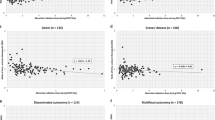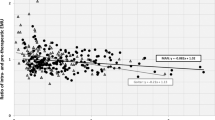Abstract.
With regard to the treatment of differentiated non-medullary thyroid carcinoma, there is controversy over whether radiation from a diagnostic radioiodine (131I) application really does have a suppressive effect on the uptake of subsequent therapeutic 131I (so-called thyroid stunning). However, inherent difficulties in exact remnant/metastatic tissue volumetry make it difficult to quantify how much diagnostic 131I is actually absorbed (absorbed energy dose) and hence to decide whether a threshold absorbed dose exists beyond which such stunning would occur. Since in benign thyroid disease the target volume can be readily quantified by ultrasonography, we sought to determine definitely whether stunning of thyroid cells occurs upon a second application of radioiodine 4 days following the first one. We therefore studied 171 consecutive patients with benign thyroid disease (diffuse goitre, Graves' disease, toxic nodular goitre) who received two-step 131I therapy during a single in-patient stay. For application of both calculated 131I activities we performed kinetic dosimetry of 131I uptake, effective half-life and absorbed dose. At the second application, patients showed significant stunning (a 31.7% decrease in 131I uptake, from 34.7%±15.4% at first application to 23.7%±12.3% at second application, P<0.0005) without a significant difference in effective half-life (4.9±1.3 vs 5.0±1.7 days, P>0.2). ANOVA showed that the extent of stunning was influenced significantly only by the absorbed energy dose at first application (F=13.5, P<0.0005), while first-application 131I activity, target volume, gender and thyroid function had no influence (all F≤0.71, all P>0.4). There was no significant correlation between extent of thyroid stunning and first-application 131I activity (r=0.07, P>0.3), whereas there was a highly significant correlation between thyroid stunning and first absorbed energy dose (r=0.64, P<0.00005), the latter correlation fitting a logarithmic model best. Multivariate factor analysis also revealed first absorbed energy dose to be the only decisive stunning factor. In conclusion, our study confirms that stunning exists in benign thyroid conditions and that it is a purely radiobiological inhibitory phenomenon related to absorbed dose.
Similar content being viewed by others
Author information
Authors and Affiliations
Additional information
Received 1 June and in revised form 9 July 2000
Electronic Publication
Rights and permissions
About this article
Cite this article
Sabri, O., Zimny, M., Schreckenberger, M. et al. Does thyroid stunning exist? A model with benign thyroid disease. Eur J Nucl Med 27, 1591–1597 (2000). https://doi.org/10.1007/s002590000348
Published:
Issue Date:
DOI: https://doi.org/10.1007/s002590000348




